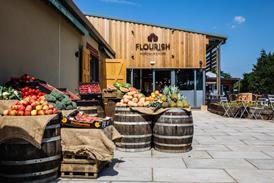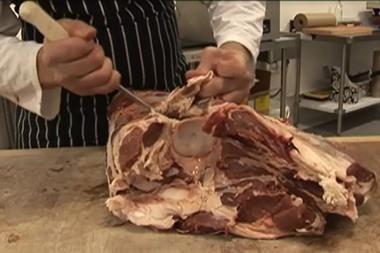Anyone for picanha steak or goose neck? Butchers are developing alternative cuts that, by making better use of the whole carcase, offer added value and value for money… but what about mass appeal?
Ribeye steak, leg of lamb, pork chops are old news. Up and down the country, enterprising butchers, retailers and foodservice operators are experimenting with new beef, pork and lamb cuts, adding flat iron steaks, mini lamb roasts and a growing array of innovative belly pork products.
What is driving them is a desire to make better use of the whole carcase - thereby reducing waste and extracting value from parts of the animal that would previously have had little, if any, retail potential. They are also responding to changing consumer tastes, as interest in nose-to-tail eating grows and celebrity chefs champion more adventurous cuts.
But with the vast majority of consumers still largely oblivious to the new cuts on the block, how much mainstream potential do they really have?
At The Butchery in London, Australian-born meat enthusiast Nathan Mills is on a mission to push the boundaries of traditional butchery with a range of “cheeky butcher’s cuts”, as he calls them. A fervent advocate of nose-to-tail butchery, he wants to get British consumers to venture outside their comfort zones by trying unusual cuts such as pope’s eye, teres major and goose neck.
All beef cuts in this instance, they are parts of the carcase that most butchers simply toss into the “trim bin” or turn into mince but which can be turned into attractive cuts, adding value, Mills argues. “The teres major is a good example,” he says. “It doesn’t even have a retail name - it’s the scientific name for a muscle deep within the shoulder - and many butchers wouldn’t even know it’s there, but it makes for a great quick-frying, grilling or barbecue cut.”
And the cuts get more adventurous still. Take goose neck - the Achilles tendon of the rear legs, which is seamed out of the heel muscle and makes for a “very unique cut for long slow cooks”, according to Mills - and the wonderfully named pope’s eye - also known as a spider steak - which sits in the pelvis and is particularly good for flash-frying.
The typical customer of The Butchery is probably more adventurous than the average supermarket shopper, Mills admits, but he believes interest in alternative cuts is starting to rise more generally. “I look a lot at what’s happening in the States, and there you have Michelin-star chefs going back to butchery,” he says. “Interest in whole-carcase butchery and what it stands for is definitely growing.”
Mills’ approach to butchery may have a decidedly high-end edge to it - he specialises in rare-breed, free-range meats and his CV includes stints at Daylesford Organic, The Ginger Pig and Jamie Oliver’s Barbecoa as well as his current work as a consultant to Whole Foods Market - but the search for new cuts is not restricted to the premium fringes of the industry. Trade bodies such as Eblex and Bpex are working with butchers to develop new cuts with mainstream appeal.
Making better use of the whole carcase makes simple commercial sense, says Eblex trade marketing manager Mike Whittemore. As meat prices are rising, new cuts - which either use less expensive parts of the animal or create smaller portions from traditional cuts - allow retailers and foodservice operators to continue to offer affordable meat.
This is particularly important for the lamb sector, which has suffered falling sales as a result of soaring per-kilo prices (see Lamb p71). “There’s a lot of work happening to create more affordable leg and shoulder purchases,” says Whittemore.
Among the new lamb cuts Eblex has researched and developed are “mini roasts” from the topside and the thick flank, bone-in lamb rumps, and a Victoria roast, which is cut from the forequarter and can be divided into four mini roasts.
The new cuts also up the ante on presentation and address consumer concerns about waste and fattiness thanks to more careful trimming. One such example is lamb rosettes - trimmed, rolled and skewered muscle portions from the shoulder - which Whittemore says are now gaining traction as a mainstream offering.
The pork sector, meanwhile, focuses on belly cuts. With volume sales up 12.5% year-on-year, belly pork has been the best-performing pork cut of the past 12 months, and its continued popularity with high-profile chefs is expected to further drive interest among consumers.
To capitalise on this, the trade has been busy coming up with new, attractive belly pork cuts. “As well as traditional roasting joints, smaller cuts are being developed to suit couples and smaller families,” says Bpex butchery and product development manager Keith Fisher. “There is also an increasing use of belly pork in the ‘quick cook’ section, such as belly ‘mini strips’, ‘thin strips’ and ‘frying strips’.”
Fisher adds that he is also seeing belly slices being promoted as “boneless spare ribs” - a practice largely restricted to foodservice, but with the potential to cross over into retail, he believes. Indeed, with the Jubilee and a “summer of sport” looming, the pork sector is keen to promote as wide a range of pork cuts as possible for barbecues and canapés. Again, belly pork is proving to be at the forefront, particularly as an inexpensive pork snack, says Fisher, but collar and shoulder pork cuts also have plenty of potential, especially if marinated.
“They are great examples of alternatives cuts suited to celebrations and sharing,” he says. “Marinated and slowly barbecued or oven-cooked, both cuts will deliver tender, succulent and flavoursome meat - consumers just need cooking tips and simple recipe inspiration.”
On the beef side, the search for alternatives to traditional steaks is dominating efforts in new product development, with Eblex working to establish cuts such as the flat iron steak and the Denver steak - taken from the feather blade and the chuck, respectively - in mainstream retailers.
These steaks are already popular in the US and are starting to make inroads in UK supermarkets. Waitrose has been selling a Hereford beef flat iron steak for some time, and Sainsbury’s listed an Aberdeen Angus flat iron steak last September.
Meanwhile, another of the new beef cuts championed by Eblex - the picanha, an alternative to the traditional rump steak - recently got a listing in Asda, which added it to its Butcher’s Selection range in April. Asda says research suggests one in three of its customers is interested in trying new meat cuts, and the new steak has gone down well with shoppers. “We have picanha in our top 100 stores in pre-pack and it is selling well so far,” a spokeswoman says.
The beef sector is also working on new cuts to tap into growing interest in slow cooking and sous vide. “It’s all the rage in foodservice already, and we’re developing cuts to fit in,” says Whittemore. Growing interest in slow cooking could add a lot of value to the chuck, he adds. “Braising steaks from the blade or the bolar are taken to a new level through slow cooking,” he says. “Cuts that would be suited to this include chuck steak on the bone, which is slow-cooked in a water bath and then flash-fried.”
With so many new cuts being developed, it is vital consumers understand them and are taught how to cook them properly. Eblex is planning to launch a “flavour/tender grid” for UK retailers this month, which scores different steaks out of five according to how tender and flavoursome they are. “It’s like a coffee or wine guide,” says Whittemore. “We know fillet will be very tender, but it won’t be as flavoursome as ribeye, so a fillet steak would score five on tenderness but four on flavour, whereas a ribeye steak would score four on tenderness and five on flavour.” The grid is a key lesson Eblex has learnt from the US, Whittemore adds, and its launch will be supported by posters as well as booklets.
So, does this flurry of activity around new cuts suggest that meat counter stalwarts have had their day? Not likely. But as consumers become more adventurous and also increasingly seek value, they may well find the new “cheeky” meats to be a cut above old favourites.
Topics
Meat & Fish Supplement 2012

The big players in meat snacks are in doldrums, but smaller players are growing strongly. Plus the EU’s…
- 1
- 2
- 3
 Currently
reading
Currently
reading
New cuts on the block
- 5
- 6
- 7
- 8
- 9




































1 Readers' comment